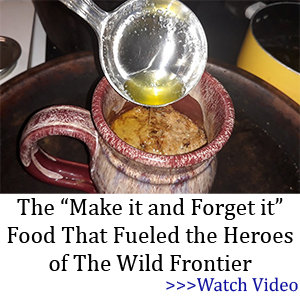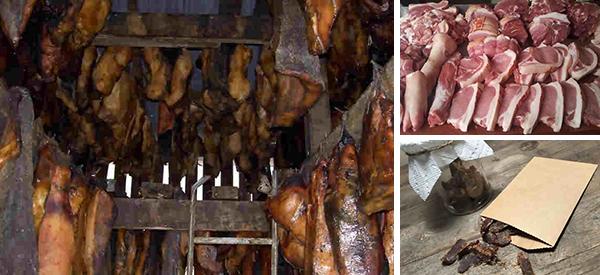In today’s day and age, most of us have access to a luxury that we often take for granted – refrigeration. We can purchase large quantities of meat at the grocery store – or even butcher our own animals at home – and either freeze or refrigerate them for later use.
But in many parts of the world, that’s not the case.
While we might enjoy the luxury of being able to choose which meats we want to eat and at what times, in some places, eating meat is less about enjoyment and more about efficiency.
In this article, I’ll tell you more about how you can keep a slaughtered animal from spoiling without refrigeration – all by eating it in a certain order.
Related: How to Slaughter and Field Dress a Cow for Year-Round Meat
“Ordered” Meat Eating – the History
Most people – though certainly not all – have access to some kind of refrigeration so it’s not necessary to eat meat in a certain order. However, in certain parts of the world, even people who have the luxury of refrigeration still eat meat from a slaughtered animal in a certain order to keep it fresh.
An example? The Eid Al Adha is a Muslim holiday celebrated in many regions of the world, including Morocco.
A much anticipated day, it begins with a special family breakfast first thing in the morning, after which time the men go to the mosque for prayers. Later in the morning, a sheep is sacrificed by the king and then each household ceremoniously sacrifices its own sheep, too.
The meat is processed in the halal tradition. After the animal has died, the skin is removed and given away. Then the meat is processed – and every single part of the animal is saved and eaten. The liver is generally eaten first, as it tends to be more perishable than the other organs. The heart and kidneys follow, with the lungs and stomach used to make a soup – all on that first day.
Related: What To Do With Your Frozen Food If The Power Goes Out
Other organ meats (and other meat from the animal’s carcass) are hung outside to dry while the head is cooked and eaten the second day. Muscle meat is eaten and used starting on the third day.
There are lots of strategies incorporated here to minimize food spoilage and exposure to flies.
This is necessary, of course, as the meat is often left hanging in extreme heat for a week or more without any kind of refrigeration. A cloth is wrapped around the animal to minimize fly exposure and all meat is then cooked well-done.
And this practice isn’t exclusive to Muslim countries – many Christian countries engage in similar practices. For example, the Greek Easter soup is made out of lamb or kid offal, including hearts, liver, lungs, and other highly perishable organs.
Why? The soup is made on Holy Saturday and eaten after midnight church services. The lamb is slaughtered a bit earlier so that the main meats (like a leg of lamb roast) can be eaten on Easter Sunday as the first meat allowed after the Lenten fast. Again, no part of the animal goes to waste and all perishable meats are eaten first.
Related: How to Make Portable Soup
What Order Should I Eat My Animal In?
You don’t necessarily need to be following a certain religious doctrine in order to incorporate some of these ideas.
Eating animals that you have slaughtered in a certain order is a great way to minimize waste, particularly if you don’t have refrigeration (although it can be done if you do have refrigeration, too, and simply want to be the most efficient butcher possible.
To come up with the proper order, you have to start with the type of animal you are slaughtering first. I won’t even mention seafood – seafood tends to be incredibly perishable and is very difficult to store without refrigeration (or some other method of preservation, like salting).
Poultry generally is the most perishable, while red meat and pork tend to last a bit longer. That’s good news, as poultry carcasses tend to be much smaller and therefore easier to eat more quickly. It’s going to take you longer to work through a whole lamb than it is a chicken!
Otherwise, eat offal first. It will spoil more quickly than the “muscle” meats of the animal. Go for the heart, liver, kidneys, and other organ meats first.
Related: The Ultimate Wild Game Meat Processing Charts for Preppers
Other Ways to Keep Meat Fresh Without Refrigeration
There are other ways to rapidly preserve meat for future use so that you can keep it fresh without refrigeration.
An easy way to do this is with salt preservation. In Morocco, a traditional method is to preserve meat in salt and then store the pieces in tubs of animal fat. You can then take out pieces and cook it just like bacon.
When you cure meat in salt, you’re adding a valuable preservation agent. Salt helps to create an environment in which bacteria can’t thrive (largely because it removes much of the moisture). When you add grease, like lard, it helps to further seal out the bacteria, just as it would if you were adding a wax cap when making jams or jellies.
You could also freeze-dry or pressure your meat, but this will require additional equipment.
Related: How To Make Potted Meat
Other methods of keeping your meat fresh include smoking and curing. Smoking is often used in regions that have too much humidity to dehydrate or air dry meat. Curing, or salting, is still used and simply requires a cold area in which you can hang your meats.
Brining is another method, which involves mixing sugar, salt, and water into a brine before submerging your meat in it.
It’s important to note that these methods work best with animals that produce a large quantity of meat, like cows, sheep, and goats.
You may have more success storing meat without refrigeration if you raise heritage breed animals, too, which are bred to be smaller and have higher fat contents, in many cases, than their industrialized counterparts. This can be super beneficial when it comes to storing meat without refrigeration.
Ultimately, you don’t have to have refrigeration in order to store your meat long term. You just need to be mindful of food spoilage rates and eat according to those timelines – and not your own personal appetites. With a bit of careful planning, you can stay safe and waste virtually no part of the animal you have slaughtered.
You may also like:
 The Ultimate Chicken Meat Processing Guide for Preppers
The Ultimate Chicken Meat Processing Guide for Preppers
New Invention 12X More Efficient Than Solar Panels (Video)
How to Keep Moisture and Pests Away from Your Food Stockpile
11 Things Native Americans Carried With Them To Survive In The Wild















i was just wundring if putting the meat in some kind of container and putting it in a cold body of water like a stream but tying it to something so it doesn’t float away could preserve it for like 5 days to a week so u have more time to smoke it if ur smoker is to small or something.
If the water temperature were 40°F or colder, it would keep the meat the same as if it were in your refrigerator. The warmer the temperature over 40, the shorter the time span the meat would remain good. Of course, if the water were cooler than air temperature, it would make the meat last longer than just hanging in the outside air. Wrapped as described would dry age it as Red points out in his post.
I am assuming you keep your refrigerator at or below 40°F.
chuck: The problem is fast spoil comes from too much blood still in the meat. Before refrigeration, people slaughtered large animals thru fall and winter, and if they could, stored carcasses under water. In cold areas, meat kept that way would remain good till spring. niio
Inuit/Eskimos, still preserve carcasses from major hunts by weighing them down with rocks and sinking them in creeks. But, now cold is the water? It flows, but is below freezing. Water is loaded with bacteria, even well water.
What’s your humidity like? I’m in Arizona and we can dry age meat because of low humidity. It doesn’t matter how hot it is, cover it to keep off the bugs, and hang it in the shade. You can salt entire carcasses, as well. This was how people used to do it to age meat before refrigeration, and why rosemary was such a popular herb. It kills the effects of food poisoning.
One cup of rosemary tea, one level teaspoon of dry leaves, put in cup, pour boiling water over that, cover steep for 10 minutes, then sip. No more than 2 cups in 24 hours! niio
“The meat is processed in the halal tradition.” You mean tortured to death don’t you?
Don’t get me wrong, I am not defending mohammadism by any means, but doesn’t halal butchering involve cutting the jugular vein of the animal cause it to lose consciousness and bleed out rather promptly? Isn’t that the same with kosher butchering? Butchering means killing the animal as quickly as possible.
Your comment sounds like some comments I got when I told the snowflakes here on the left coast that I was going to hunt bison. “Oh, are you going to kill it?” “Well, yeah, it helps if they are dead before you try to eat them.”
Well, I went on line and looked up halal and kosher butchering and it was as I suspected. The jugular vein, the carotid artery and the windpipe must be cut in one swipe of the blade. In many halal meat processing plants the animal is stunned ahead of time just as in non-halal. I didn’t read of any stunning in kosher butchering. The emphasis, as in non-religious slaughter is ending the animal’s life as quickly as possible. A butchering process where the animal is dead in under a minute doesn’t sound like a torture session to me, especially where the artery that supplies blood to the brain is severed so that the blood supply to the brain is interrupted. The animal may not be medically dead but is unconscious in a very brief period of time. Choking out someone in a martial arts choke hold takes less than five seconds and it is the same process, interrupting the blood flow to the brain. That’s why on the operating table when the victim (also know as the patient) flatlines, the medical team has three seconds to get blood flowing to the brain before brain injury starts to occur. That’s also why if you don’t want to be left as a semi-vegetable after an operation you should seriously think about a Do Not Resuscitate notation on your medical release for the surgery. Not saying you should have that in all instances, but before surgery you should consider that if you flatline, there is a 3-second deadline until you start to lose brain function.
My cardiologist suggested some reading for me to do and he got me interested in reading books on medical procedure and the development of various cures and inoculations. In one book the doctor was talking about mistakes such as accidentally slicing the vena cava, a very major vessel returning blood to the heart. The patient bled out completely before they could get the vessel sewed back to where it didn’t leak. They actually completely replaced the patient’s total blood supply with replacement blood before they completed the repair. The patient was flatline for over 3 seconds. He was left with a speech impediment and a partially paralyzed left side as a result of oxygen deprivation to the brain as a result of the loss of blood supply to the brain. In one way he was lucky that the brain damage wasn’t more severe. He could easily have been left in a vegetative state for the rest of his life. On the other hand, not so lucky that his surgeon was a klutz.
From time to time we have escapees from Halal butchers backyards running through our city streets with the butchers wielding long knives running right after them. If they manage to catch them, they slaughter them right on the street. Don’t care who might be there either or whose property they are on.
City: One son-in-law is from Bangladesh, and he has pictures of people standing near the border with India enticing ‘free’ cattle over the line, then slaughtering them. While this might seem like stealing, the cattle are allowed to roam free and have no owner, and truth be known a lot of Indians would like to see the herds cut down. They steal food and no one is allowed to stop them. Hurt people, block traffic and make a mess in the city.
If they’re allowed to do this, you should be allowed to keep a few ‘pets’ for meat or eggs. niio
Gourd: No, they only to do to people. “And the infidel shall be as lamb to you.”
The animal is not allowed to suffer or the meat can’t be used. Halal meat is to be sold within 24 hours, if memory serves, and any pain means the muscles tighten and the meat is tough. given they usually prefer older animals, you might need an ax to cut the gravy, anyway. why make it worse.
Moses Law contains the first known regulations on animal rights, even to not insulting animals. Muslims adopted some of it.
niio
can’t you make jerky out of it add water to it when your ready to eat it?
I have never tried reconstituting jerky. I suspect that it takes more than just soaking it in water to get it to some sort of softened state. When my mother prepared dried beef it was usually creamed and she cooked it some period of time. It also was sliced much thinner than jerky usually is. It has been a long time since I bought a jar of dried beef but to my recollection, the dried beef was sliced almost paper thin.
chuck: Dried beef is good. But, if for jerky has to be cut, then soaked. Salt is added because it’ll stay moist enough to gnaw on. Dried straight, it needs to be chopped first, then soaked overnight. It’s still tough, but good. We get it at the store for $27/lb for beef. Best way, cook it first, then defat and dry it for sopa seca, dry soup. Fat is deep-fried and can be stored for months to use in stews and some sausages. niio
Natives dry meat here totally unseasoned. They like the natural flavor to chew on but it’s easy to break it up in to water and make a good soup or stew.
Reminds me again of why I built a walk-in cooler to home process our beef and pork.
Reminds me of the joke about a 3 legged pig…
After my grampa was married, he had a three-legged pig, that would hobble from the pig waterer to the feed trough and squeal all the way. Grampa got so tired of that squealing he finally slaughtered, butchered, and cut/wrapped the pig meat – also smoked one ham. But he carefully kept the squeal, wrapped it up and fed it to his wife, my Gramma. That squeal found its way to my gramma’s X chromosomes and attached itself there. All the female offspring have been squealers ever since.
Under survival conditions, I would think you would quickly eat all the meat you can before it spoils while you use whatever means you have to preserve the rest. Grampa would smoke whatever he could while Gramma would fry or boil what she could and then can it. Grampa would wrap the smoked meat in burlap with salt sprinkled on the smoked meat. Then he would bury it in a pile of straw that had blocks of ice cut from the creek placed in the straw, both under and around the smoked meat. They usually slaughtered hogs late in the fall, and the smoked meat and ice would last through August the following summer.
There’s a hundred variations on this joke – relevant way to preserve meat 😉
A TV reporter became lost on the back roads and stopped at a farm to get directions. As he was talking to the farmer he noticed a pig with a wooden leg. “This could be a great story for the Six O’Clock News. How did that pig lose his leg?” he asked the farmer. “Well”, said the farmer, “that’s a very special pig. One night not too long ago we had a fire start in the barn, and that pig squealed so loud and long that he woke everyone, and by the time we got there he had herded all the other animals out of the barn. Saved them all.”
“And that was when he hurt his leg?” asked the journalist anxious for a story. “Nope, he pulled through that just fine.” said the farmer. “Though a while later, I was back in the woods when a bear attacked me. Well, sir, that pig was nearby and he came running and rammed that bear from behind and then chased him off. He saved me for sure.”
“Wow! So the bear injured his leg then?” questioned the reporter. “No. He came away without a scratch. Though a few days later, my tractor turned over in a ditch and I was knocked unconscious. Well, that pig dove into the ditch and pulled me out before I got cut up in the machinery.” “Ahh! So his leg got caught under the tractor?” asked the journalist. “Noooo. We both walked away from that one.” says the farmer.
“So how did he get the wooden leg?” asked the journalist. “Well”, the farmer replied, “A pig that special shouldn’t be eaten all at once”!
It’s called dry ageing, hang the carcass in shade, and wrap with muslin or a sheet. Cow camps too far from home on back roads still do this, as do hunting camps. Most folks prefer to use powdered chili peppers under the cloth. That keeps away bears and coyotes, as well as flies. niio
Meat sliced 2 inches thick, packed in chilis, and roasted is one of the most delicious things I’ve ever had, especially with chili pequin. What a one of a kind flavor!
Mike: Take a pound of cooked pintos, put them in the pan with some onions, then the chilis and meat. Roast till the meat is done. Best refritos I ever had. niio
I once ate some two week old, dry aged in camp, deer meat. It was the most tender I’d ever eaten. Great flavor. They key is to quickly hang it so blood drains well, empty the body cavity, and skin it. Then cover it unless its late enough into fall that flies are gone in cold country. Let the outer meat air dry. Cut off enough for a meal at a time and enjoy.
ClergyLady: Old timey cowboy ways 🙂 A little dusting of red pepper keeps off coyotes and bears. niio
The tradition of Halal & kosher slaughter or Bleeding the animal stemmed form the belief that disease was caused by the blood of the animal this became a part of hygiene law not religious law. When done properly by a experienced butcher it is one quick cut and very quick to die. This is not quick if practiced by a mass production slaughter house as they have no respect for the animal so it is a long and painful death and the cheapest but there are better ways with a little extra cost but business as usual still prevales. Ps. The stunning process has been proven not to work very well,it only parallelizes the animal long enough to slaughter them but they are still alive and awake and feel pain it does not anesthetize the animal so it does not feel pain but it makes the animal easier to control when slaughtering.
Nick: Blood spoils much faster than meat. If you’re cut by high-quality flint, you don’t feel it. Modern slaughterhouses use a stungun that can pierce the brain. We used a .22. For poultry, open the mouth and pierce the brain, then cut the jugulars. It’s true tho, that the bigger the slaughterhouse, the less humanity you’ll see. That and feed lots should be banned. niio
Eat smaller animals, like dogs and cats, squirrels and rabbits.
I have been advised by folks who claim first hand knowledge that brown dog is more flavorful than black dog. Don’t have a clue about cats.